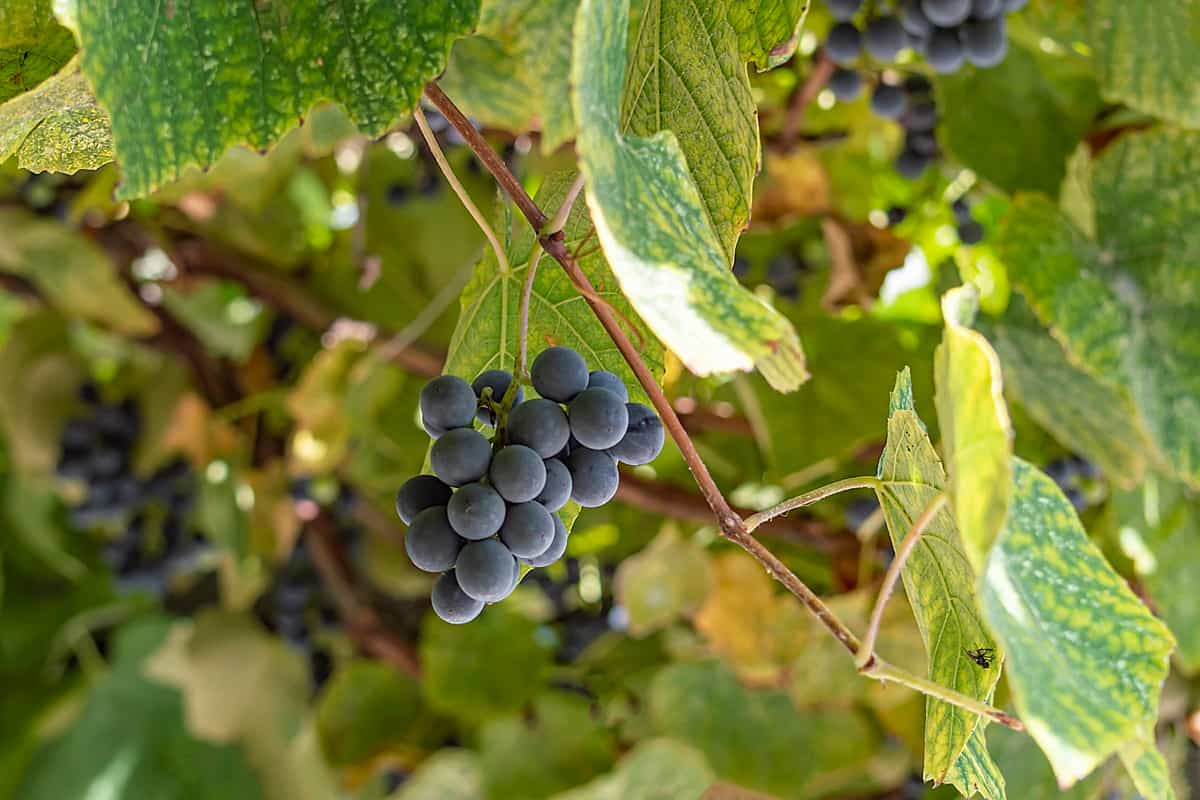Black Muscat, also known as Muscat of Hamburg or Black Hamburg, is a delightful variety of grape that captivates both wine enthusiasts and fruit lovers alike. Growing Black Muscat grapes in home gardens comes with many benefits that make it a good choice for any grape enthusiast. Derived from a cross between Schiava Grossa and Muscat of Alexandria grapes, Black Muscat combines the best characteristics of both parent varieties.

Growing Black Muscat Grapes
Choosing the Right Variety
Choosing the right variety of Black Muscat grapes is an important step in successfully growing them in your home garden. The main factor for selecting a variety is the climate in your area. Some varieties are better for warmer climates, while others can tolerate colder temperatures. It’s important to select a variety that will thrive in your specific climate zone. Another consideration is the size and flavor of the grapes. Black Muscat grapes come in various sizes and have different levels of sweetness.
Planting Your Tree
Timing
Timing is everything when it comes to planting Black Muscat grape vines in your home garden. Ideally, it would help if you planted them in the early spring or late fall when the weather is mild. This allows the vines to establish themselves before the harsh conditions of winter or summer set in.
Location
When choosing a location for your Black Muscat grape vines, keep in mind that they need full sun exposure for at least 6-8 hours a day. Look for a spot with well-draining soil and good air circulation. Avoid areas prone to frost pockets or strong winds that can damage the delicate vines.
Soil
The soil plays an important role in the growth of Black Muscat grapes. The grape vine prefers loamy soil with a pH level of 5.5 and 6.5. Before planting the grape vine, amend your soil with organic matter to improve its drainage.
Propagation Methods
Propagation methods for Black Muscat grapes are essential for home gardeners looking to expand their vineyard. There are a few different techniques that can be used successfully, depending on your preference and experience level. One common method is through cuttings. Take a healthy stem cutting from an existing vine during the dormant season, usually in late winter or early spring. Make sure the cutting is about 8-12 inches long with at least three nodes.
In case you missed it: The Ultimate Guide to Growing Kyoho Grapes in Home Gardens

Remove any lower portion leaves of the cutting and dip them into rooting hormone before planting cuttings in a well-draining potting mix. Another propagation method is layering, which involves bending one of the vine’s branches down to the ground and burying a section of it under the soil, though attached to the parent plant. Over time, roots will develop from this buried section, allowing you to sever it from the main plant and transplant it elsewhere in your garden.
Grafting is also an option for propagating Black Muscat grapes. This method involves connecting two different grape varieties by joining their stems or buds together so they grow as one plant. Grafting requires some skill and knowledge but can result in stronger plants that bear fruit more quickly.
Watering and Mulching
Proper watering ensures that the vines receive enough moisture to thrive, while mulching helps retain soil moisture and suppress weed growth. It’s important to water deeply but infrequently, allowing the soil to dry out between waterings. This encourages deep root growth and prevents overwatering, which can lead to root rot.
Mulching around the base of the grapevines offers several benefits. It acts as a barrier for weeds that compete with the vines for nutrients and water. Organic mulches are ideal choices for Black Muscat grapes. These materials gradually break down over time, enriching the soil with organic matter.
Fertilizing
Providing your vines with the right nutrients can greatly enhance their growth and overall health. It’s important to choose a balanced fertilizer that contains all the necessary elements for grapevine nutrition. A fertilizer with a ratio of N, P, and K, such as 10-10-10 or 14-14-14, is typically recommended.
When it comes to timing, it’s best to apply fertilizer in early spring before the vines start actively growing. This allows them to absorb the nutrients gradually throughout the season. To apply the fertilizer, evenly spread it around the base of each vine, taking care not to contact the leaves or stems directly. Gently work it into the top layer of soil using a rake or hoe.
Pruning and Training
These practices help promote healthy growth, improve fruit production, and maintain the overall vine shape. When it comes to pruning, you should start by removing any dead or damaged wood. This will not only enhance the appearance of the vine but also prevent diseases from spreading.
Next, thin out crowded areas to allow more airflow and sunlight penetration. Training your Black Muscat grape vine involves directing its growth onto a support system or trellis. This helps keep the plant organized and prevents it from sprawling all over your garden. You can use stakes or wires to guide the vines along a desired path.
Pest and Disease Management
One common pest that affects Black Muscat grape vines is the grapevine leafhopper. These insects feed on the plant leaves, causing them to yellow and curl. To control leafhoppers, you can use organic insecticides or introduce beneficial insects. Another pesky pest is the grape flea beetle, which feeds on young leaves and buds. You can manually remove these beetles or use insecticidal soap to keep their population in check.
In case you missed it: The Ultimate Guide to Growing Flame Seedless Grapes in Home Gardens

Diseases like powdery mildew and black rot can also affect Black Muscat grapes. Powdery mildew disease appears as a white color powdery coating on the leaves, while black rot causes dark lesions on the fruit. To prevent these diseases, it’s essential to provide good air circulation around your vines by pruning them regularly. Applying fungicides at recommended intervals can also help in controlling these diseases.
When and How to Harvest
The timing of the harvest of Black Muscat grapes depends on several factors, including the desired sweetness level, color development, and overall grape maturity. To determine if your grapes are ready for harvesting, start by tasting a few berries from different parts of the bunch. Look for a balance between sweetness and acidity – you want them to be sweet but not overly sugary.
Additionally, check the color of the grapes; they should have reached their full hue. When it’s time to harvest, use sharp pruning shears or scissors to cut each cluster from the vine carefully. Be gentle to avoid damaging both the fruit and surrounding foliage.
Winter Care
Winter is the perfect time to prune your grapevines. Remove any diseased wood, as well as any weak or overcrowded branches. This will help promote new plant growth and improve air circulation around the plant. Apply an organic mulch layer around the grape vine base to protect them from freezing temperatures. While you don’t need to water your grape plants as frequently during winter, it’s still important to monitor soil moisture levels. Water sparingly if necessary, making sure not to overwater the grape vine as this can lead to root rot.
Growing in Containers
Growing Black Muscat grapes in containers is a great option for those who have limited space or live in urban areas. When choosing a container, opt for one that is at least 20 inches deep and has good drainage. Make sure to fill it with quality potting soil that is well-draining soil and rich in organic matter. Place your container in a sunny spot where the vine will receive at least six hours of direct sunlight each day. This will ensure optimal fruit production. Regular watering is crucial when growing grapes in containers.
Yield
The amount of fruit you can expect to harvest will depend on various factors, such as the health and age of the vine, as well as how well it has been cared for. When properly grown and maintained, a mature Black Muscat grapevine can yield a generous amount of fruit. A single Black Muscat grape vine yield can produce up to 20 to 50 pounds of grapes per season. However, it’s important to note that this may vary depending on your specific growing conditions.
In case you missed it: How to Build a Trellis for Grape Vines: DIY From Design Layout to Installation

Conclusion
Cultivating this grape variety at home helps support biodiversity by diversifying the range of plant species in your garden. In addition to these benefits, growing Black Muscat grapes in home gardens also add aesthetic value to your outdoor space. The vines provide lush green foliage throughout the season and produce beautiful clusters of rich purple-black fruit.
- Feed Your Flock for Less: Top 10 Tips to Save on Chicken Feed
- Ultimate Guide to Ossabaw Island Hog: Breeding, Raising, Diet, and Care
- Hatching Answers: The Top 10 Reasons Your Chickens Aren’t Laying Eggs
- Eggs and Economics: Breaking Down the Cost of Raising Backyard Chickens
- Defend Your Greens: Proven Methods to Keep Iguanas Out of Your Garden
- Ultimate Guide to Cinnamon Queen Chicken: A Comprehensive Guide for Beginners
- Ultimate Guide to California Tan Chicken: Breeding, Raising, Diet, Egg-Production and Care
- Ultimate Guide to Marsh Daisy Chicken: Breeding, Raising, Diet, and Care
- 10 Types of Chicken Farming Businesses You Can Start for Profits